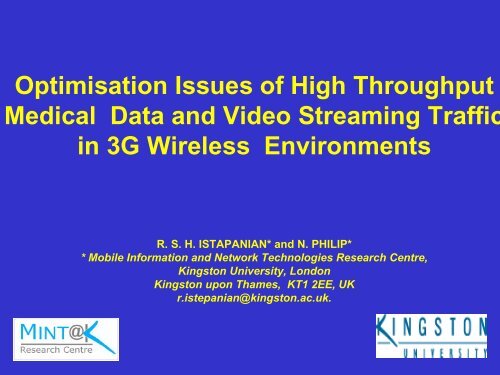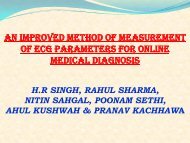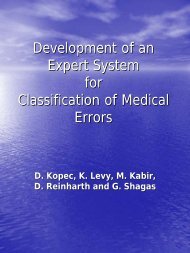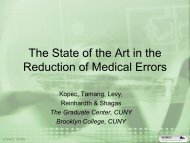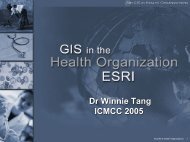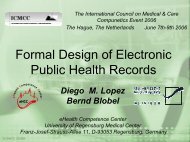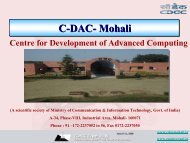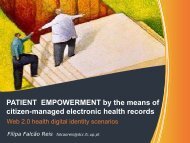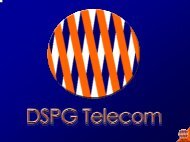Robot Control - ICMCC
Robot Control - ICMCC
Robot Control - ICMCC
Create successful ePaper yourself
Turn your PDF publications into a flip-book with our unique Google optimized e-Paper software.
Optimisation Issues of High Throughput<br />
Medical Data and Video Streaming Traffic<br />
in 3G Wireless Environments<br />
R. S. H. ISTAPANIAN* and N. PHILIP*<br />
* Mobile Information and Network Technologies Research Centre,<br />
Kingston University, London<br />
Kingston upon Thames, KT1 2EE, UK<br />
r.istepanian@kingston.ac.uk.
M- Health : Emerging Mobile Communications<br />
and Network Technologies for healthcare<br />
Istepanian (etal.) , IEEE Trans. Information Technologies in Biomedicine,<br />
Vol. 8, 4, DEc. 2004.
Introduction:<br />
• OTELO system Medical and non medical data.<br />
• still Images<br />
• <strong>Robot</strong> <strong>Control</strong><br />
• Medical video streaming<br />
• video conference<br />
• 3G QoS for Ultrasound requirements.<br />
• Soft Computing and Optimization issues in 3G – medical QoS<br />
(m-QoS) will be discussed here and especially Multiobjective<br />
optimization methodology based on Adaptive Simulated<br />
Annealing (ASA).
OTELO System – Introduction<br />
EU-IST Funded Project (2001-2004)
Expert station - Input Device<br />
To <strong>Control</strong> the Patient station<br />
robot:<br />
• One DoF hand free Input device<br />
• Easy to use, comparable to<br />
standard probe<br />
• 6DOF localisation sensor - Flock of<br />
Bird TM
Patient Station<br />
<strong>Robot</strong> <strong>Control</strong>ler Unit<br />
Videoconference<br />
System<br />
<strong>Robot</strong>ic Head &<br />
US Probe Holder<br />
Ultrasound<br />
Machine
EXPERT & PATIENT Stations
Ultrasound Holder (<strong>Robot</strong>ic Arm)
OTELO Medical & Non-Medical Data Requirements<br />
Expert Station<br />
• Video-conference<br />
3G Uplink<br />
• <strong>Robot</strong> <strong>Control</strong><br />
• Video-conference<br />
• <strong>Robot</strong> <strong>Control</strong><br />
• Force feedback<br />
• Dynamic US images<br />
• Still US Images<br />
3G Downlink<br />
• Fictive Probe force<br />
Patient station
Table 1. OTELO medical data requirements and corresponding data rates.<br />
Ultrasound video<br />
stream<br />
Ultrasound still<br />
images<br />
Ambient video<br />
stream<br />
Voice<br />
<strong>Robot</strong> control<br />
data<br />
Flow direction<br />
Simplex:<br />
Patient to Expert<br />
Simplex:<br />
Patient to Expert<br />
Duplex Duplex duplex<br />
Transport<br />
Protocol<br />
Speed<br />
Requirement<br />
RTP/UDP/IP TCP/IP RTP/ UDP/IP RTP/UDP/IP UDP/IP<br />
Real-time Non Real-time Real-time Real-time Real-time<br />
Payload data<br />
rate<br />
requirement<br />
over the airinterface<br />
(without protocol<br />
headers)<br />
15 frames/s<br />
@ 210 kbit/s<br />
Uplink<br />
1 frame/ 10s<br />
Uplink<br />
15 to 1 frame/s<br />
symmetrically<br />
16 kbit/s<br />
symmetrically<br />
0.3 kbit/s<br />
symmetrically<br />
The detailed medical and non-medical OTELO data traffic are shown in Table 1.<br />
From this table it can be seen that the most traffic and bandwidth demanding<br />
OTELO traffic type is the medical video streaming traffic of the system.
OTELO Functional Modalities and Data Follow<br />
Medical Data<br />
Still US Images<br />
Stream US<br />
Images<br />
Stream US<br />
Images<br />
<strong>Robot</strong>ic Arm control<br />
Frequency<br />
Medium Qlty.<br />
Videoconf<br />
High Qlty.<br />
Videoconf.<br />
Data<br />
Description<br />
Gray Scale,<br />
512x512 Pixel<br />
Gray Scale,<br />
CIF (Regon Of Interest),<br />
200x200 Pixel<br />
Gray Scale,<br />
CIF, 352x288 Pixel<br />
Data Rates<br />
&<br />
Resolution<br />
14-97<br />
Kbyte<br />
Data Flow<br />
Direction<br />
Up-link<br />
P-to-E<br />
10 fps Up-link<br />
P-to-E<br />
7 fps Up-link<br />
P-to-E<br />
100-200 Hz 3-4 Kbps UP or Down<br />
Link, E-to-P, P-to-E<br />
QCIF<br />
176x144<br />
QCIF<br />
176x144<br />
CIF<br />
352x288<br />
5 fps Up & Down<br />
P-to-E, E-to-P<br />
7.5 fps Up & Down<br />
P-to-E, E-to-P<br />
5 fps Up & Down<br />
P-to-E, E-to-P
Transmitted image<br />
Received image<br />
2 cm hyperechoic focal lesion in<br />
deeper part of the right liver
Therefore we should implement ‘some control mechanism’ that will<br />
adhere within these bounds:<br />
1- OTELO’s user (QoS) requirement<br />
2- the Network QoS requirements<br />
From the Clinical Trials of the system and the experts<br />
evaluation of the diagnostic quality of the received US<br />
image and stream, that the communication bounds<br />
for efficient diagnosis using the OTELO system are:<br />
1. Frame rate of the received images >= 5fps ( kbps)<br />
2. Peak Signal to Noise Ratio (PSNR) >= 36dB<br />
3. The average delay of Probe movement-to-Received<br />
image at the Patient station is < 350 ms<br />
These are called Medical ‘user QoS’ requirements
3G OTELO Performance analysis studies :<br />
1. Evaluate the performance of the OTELO <strong>Robot</strong>ic system<br />
over UMTS network.<br />
2. To study the effect of multiplexed data transmission on<br />
the Real-time performance.<br />
3. Subjective and objective evaluation of the received data<br />
Garawi, (etal.) , ‘ Performance Analysis of a Compact <strong>Robot</strong>ic Tele-Echography<br />
E-Health System over Terrestrial and Mobile CommunicationLinks’, Proc.<br />
5th. IEE International Conference on 3G Mobile Communication<br />
Technologies- 3G 2004, London, 18-20, October, pp.118-122, 2004.
OTELO System on UMTS network<br />
GGSN<br />
SGSN<br />
UTRAN<br />
3G<br />
Core Network<br />
GMSC<br />
PSTN<br />
ISDN or ADSL<br />
RNC<br />
Node B<br />
Node B<br />
- Ambient Video<br />
- Voice<br />
- <strong>Robot</strong> <strong>Control</strong><br />
Downlink:<br />
3G mobile handset<br />
(or PCMCIA card)<br />
(Patient) Mobile<br />
OTELO Station<br />
GateAway<br />
<strong>Robot</strong> <strong>Control</strong><br />
Unit<br />
Modem<br />
Uplink:<br />
- US video stream<br />
or Ambient Video<br />
- US still images<br />
- Voice<br />
- <strong>Robot</strong> <strong>Control</strong><br />
Probe Holder<br />
<strong>Robot</strong><br />
<strong>Robot</strong>ic<br />
<strong>Control</strong> Input<br />
Device<br />
Audio-Video<br />
Device<br />
Expert Station<br />
Audio-Video<br />
Device<br />
Echograph<br />
Device
Ultrasound data stream throughput<br />
Intantaneous recieved throuhput Vs time<br />
Average total<br />
throughput:<br />
19.7 Kbps<br />
Average US video<br />
stream throughput:<br />
12.7 Kbps<br />
Throughput (Kbps)<br />
100<br />
90<br />
80<br />
70<br />
60<br />
50<br />
40<br />
30<br />
20<br />
10<br />
0<br />
<strong>Robot</strong>ic<br />
Data<br />
<strong>Robot</strong>ic Data +<br />
US stream<br />
Average throughput<br />
0 20 40 60 80 100 120 140<br />
Time (s)<br />
Total throughput for the control & ultrasound data received<br />
at the Expert station, UMTS Uplink Data rate = 64Kbps.
Supporting robust video communications over 3G wireless<br />
networks is a significant problem, primarily because of two<br />
factors:<br />
• Low bandwidth.<br />
• Time varying error characteristics of the transmission channel.<br />
This will cause congestion and then degradation in the network<br />
performance:<br />
• utilization<br />
• packet losses<br />
• higher delay<br />
• delay jitter<br />
These are called generally 3G Network QoS.
Adaptive simulated Annealing in the medical 3G network optimization<br />
Initialization (algorithm parameters)<br />
Generate a new<br />
frame rate<br />
Accept or reject<br />
no<br />
accept<br />
yes<br />
Adapt the next<br />
walk to the topography<br />
of the required 3G m-QoS<br />
Reduce temperature<br />
No<br />
3G m-QoS<br />
condition<br />
satisfied<br />
Yes<br />
End
The proposed Optimization Technique:<br />
In this work we introduce Adaptive Simulated Annealing (ASA)<br />
Optimization technique and apply it for this multiobjective<br />
optimization problem. In particular we consider the packet<br />
loss and delay Jitter objectives function (Фi), therefore the<br />
algebraic inequality here are:<br />
Packet loss<br />
Delay Jitter<br />
φ<br />
φ<br />
r ) 1<br />
( ≤ ε<br />
r)<br />
2<br />
( ≤ ε<br />
1<br />
2<br />
ε 1 ε 2<br />
, are the limits of these inequalities.
The proposed Optimization Technique:<br />
These can be combined as one equation that the optimization<br />
techniques will work on to find the optimum rate.<br />
⎧ ⎧φi(<br />
r)<br />
−εi<br />
⎫ ⎫<br />
E( r)<br />
= max⎨max⎨<br />
,0⎬<br />
: i = 1, 2⎬<br />
⎩ ⎩ ωi<br />
⎭ ⎭<br />
Ф is the objective function,<br />
i is the number of QoS metrics elements,<br />
r is the rate control value,<br />
ω is the weightings.
End-to-End System Architecture
Conclusions and future work:<br />
(This is ongoing research)<br />
• The OTELO ultrasound stream is the most traffic demanding .<br />
• New QoS metrics for medical applications<br />
• Multiobjective optimization technique base (ASA) is considered<br />
to find the optimal frame rate that satisfy the QoS of the<br />
received images.<br />
• Network monitoring is used here to feedback the packet loss<br />
and delay jitter using the RTCP receiver report.<br />
• Packet Loss and delay jitter is considered here as our objective<br />
functions. PSNR will be added later to the optimisation problem
Acknowledgments:<br />
EU-IST for funding the OTELO project<br />
Vodafone R&D, UK
THANK YOU<br />
Robert S. H. Istepanian<br />
r.istepanian@kingston.ac.uk<br />
www.kingston.ac.uk/MINT


